Museums and Exhibitions in New York City and Vicinity
| Home | | Museum Guide | | International | | Architecture & Design | | Theater |
GLENN LONEY'S MUSEUM NOTES
CONTENTS, November, 2001
[01] Met Museum Focus on Middle East
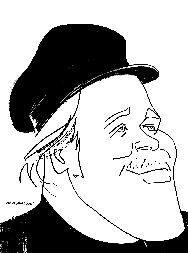
Caricature of Glenn Loney
by Sam Norkin.
[02] Early Photos Along the Nile
[03] Harry Burton/King Tut's Photographer
[04] Hindu Devotions: Meeting God
[05] PEARLS at the American Museum
[06] Mughal Jewels at the Met
[07] Glass of the Sultans
[08] Bruegel the Elder: Drawings & Prints
[09] Caspar David Friedrich: MOONWATCHERS
[10] Beckford at the Bard Center
[11] Academic Religious Art at Dahesh
[12] Oscar Wilde in Six Acts at Morgan Library
[13] Paul Signac: Seurat's Disciple
[14] Candace Wheeler—American Woman Designer
[15] Alberto Giacometti at MoMA
[16] Al Hirschfeld's NEW York
[17] VITAL FORMS in Brooklyn
[18] BRAZIL at the Guggenheim
[19] Major Book about Brazil
[20] At the Whitney: Alex Katz
[21] Projected Images as American Art
[22] MoMA Moves To Queens
You can use your browser's "find" function to skip to articles on any of these topics instead of scrolling down. Click the "FIND" button or drop down the "EDIT" menu and choose "FIND."
For editorial and commercial uses of the Glenn Loney INFOTOGRAPHY/ArtsArchive of international photo-images, contact THE EVERETT COLLECTION, 104 West 27th Street, NYC 10010. Phone: 212-255-8610/FAX: 212-255-8612.
Copyright © 2000 Glenn Loney.
For a selection of Glenn Loney's previous columns, click here.
FOCUS ON THE MIDDLE EAST—
Met Museum's Photos of Pre-Islamic Egypt!
Were the Egyptians of the Age of Cheops—or the Time of King Tut—actually Arabs? Or were they of an earlier tribal group? Some African-Americans are convinced that they were actually a black race, not Arabs at all.
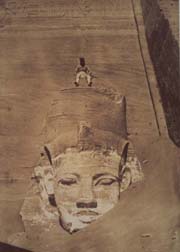
|
|
| FACE OF PHARAOH--Maxime Du Camp's mid-19th century photo of Abu Simbel Temple engulfed in sand. | |
In any case, it is beyond argument that Cleopatra VII was not a Black African Queen. She was the last of the Ptolemaic Dynasty, founded by Ptolemy, one of Alexander the Great's generals.
Two current photo-exhibitions at the Metropolitan Museum focus on the battered monuments of Egyptian Antiquity. In so doing, however, they present some interesting contrasts between the camera-records of carved or painted facial features of the pharaohs and their people and photographic images of 19th and 20th century Arab Egyptians who guided European photographers and archeologists to great ruined temples, colossal statues, and burial sites.
So the two shows offer visions of pre-Islamic Egypt along with the Egypt of the People of the Holy Qur'an, blessed be the name.
In the light of—or, more properly, the darkness of—the September 11 Disaster, these exhibitions take on added interest. Especially for those who have never been to Egypt or the Middle East and have little idea about the Land and People.
Along The Nile:
Early Photographs of Egypt—
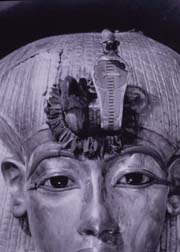
|
|
| EYES OF KING TUT--Harry Burton's photo of Tutankhamun's face on Outer Coffin. | |
Of course, even in the Renaissance—but especially in the 18th century—there were both scholars and adventurers who ventured into Egypt and the "Cradle of Civilization" to sketch, describe, and even excavate some of the ancient artifacts.
But the camera made a major difference in recording both massive monuments and minor fragments of the past. Unfortunately, much of potential interest had already eroded, been vandalized, or stolen before the professional lensmen arrived on the various scenes.
These early Egyptian photographs are all the more valuable records because erosion, theft, vandalism, and change continue. Some of the images made 150 years ago show monuments which no longer look like that.
Maxime Du Camp's impressive 1850 plate of a tiny Arab guide perched atop an immense pharaonic crown is a prime example. A mountain of sand covers even the pharaonic chin, so the daring guide was able to climb up to his regal plateau hand-over-hand.
At the left side of the photo is an immense clean cleft in the stone cliff of which the face is a part. This is the famed Temple of Re at Abu Simbel.
This sculpted fissure only suggests the grandeur of what is concealed below, under the massive drifts of sand—including the full bodies of four gargantuan pharaonic images. In Du Camp's time—as at the Great Sphinx—the sands of time had engulfed much of the then mysterious monument.
Today, Du Camp would not recognize the site. Nor would he have done so in the late 1950s. At that time, I was able to sail up the Nile in a small boat to see the temple freed of sand, with the Pharaohs standing tall.
Some time after that—because of the rising waters behind the Aswan Dam—to save the temple from vanishing beneath the risen Nile, UNESCO sponsored a gigantic preservation project. The figures and the temple were sawed into sections and raised to the top of the cliff. Where they now look out over the land in splendor.
Napoleon's Egyptian Campaign brought renewed interest to that ancient land's antiquities. Some of its great treasures were removed to the Louvre and the Place de la Concorde. And France's Champollion was able, at last, to unlock the mystery of hieroglyphics with the Rosetta Stone.
So it's not surprising that some of the best of these photos in the current Met show were taken by French photographers. But the German scholar-explorers were not far behind. And the English, as well—for they supplanted the French as the "European Presence" in Ottoman-ruled Egypt.
Among the lensmen included in the exhibition: Du Camp, Félix Teynard, Gustave Le Gray, Ernest Benecke, W. Hammerschmidt, Francis Frith, & John Beasley Greene.
The Pharaoh's Photographer:
Harry Burton, Tutankhamun,
And the Met's Egyptian Expedition
[Closing December 30, 2001] When King Tut's Tomb was finally
discovered and opened in 1922—by Howard Carter and his wealthy patron, Lord
Carnarvon—it was front-page news. Its untouched and magnificent treasures, sealed
for centuries—millennia, in fact—were major items of interest in newspapers,
magazines, and books.
That they were so popular was not only owing to their own brilliance and richness as works of art. Nor only to the aura of mystery which surrounded them: Why had the pharaoh's court officials spent so much time & money, used so much art & craftsmanship, to create the objects found in the tomb?
These points of interest were heightened by the remarkable photographs made by Harry Burton of the dig itself, the objects in situ in the tomb, and in the expedition's workshop. A special issue of The National Geographic was devoted to this amazing discovery and its treasures.
[Personal Disclosure: It was this copy of the Geographic which made me long ago long to go to Egypt and discover a mummy on my own. I was one of ten students in the one-room Indian Springs Elementary School in the California Sierras. It had been built in 1859 as a Young Ladies' Seminary and, thus, had a remarkable library: Mark Twain & Bret Harte in classic complete editions. And a long-term subscription to the Geographic!
[In the event, my trip up the Nile to Abu Simbel had to take the place of hunting mummies in the boundless sands of Egypt. But there are still many mummies hidden in the sands, waiting to be discovered. So, someday maybe…]
The Mummy's Curse! When I first saw Burton's photographs of Tut's Tomb, there was already a kind of Urban Legend—or should it be Archeological Legend?—connected to the discovery and dig.
It was said that King Tut had laid a curse on anyone who dared to violate his tomb. Tomb-robbers and envious successors were the most he had to fear. He could not have imagined men like Carter and Carnarvon.
Can you imagine archeologists wanting to open the Woolworth, Juilliard, Westinghouse, or O. H. P. Belmont Mausoleums in Woodlawn Cemetery in some distant time? Or Harry Helmsley's elegant tomb, with its Art-Deco stained-glass view of the Manhattan skyline?
Harry Burton, of course, won't be on hand to record the tomb-openings. But the Mummy's Curse—which was said to have claimed the lives of both Howard Carter and Lord Carnarvon—apparently didn't affect him.
He lived until 1940 and photographed other expeditions, but the images from Tut's Tomb are among his best-known. In 1914, he had already been commissioned by the Met Museum to record the great monuments and hieroglyphics at Thebes.
For the Met, he spent some eight years photographing Tut's Tomb and its many magnificent artifacts.
The 60 Burton photos now on view have never been shown to the public before. They range from 1918 to 1939, just before he died. But not of the Mummy's Curse!
One exciting dividend of his archeological photography was learning to operate a motion-picture camera. So there is also some lively footage of hordes of Arab workers removing acres of sand from excavations sites.
Unlike a Cecil B. DeMille Spectacular of Building the Pyramids, Burton's film-footage is rather more like re-discovering and uncovering them…
With the Muslim Fundamentalist Taliban's destruction of the ancient Great Buddhas in Afghanistan, the West may have even more reason to thank Harry Burton for photographing and recording Egyptian Temples, Gods, and Kings.
The Last of the Prophets, Muhammad, forbade Graven Images, as is also commanded in the Biblical Ten Commandments.
To this day, especially devout Muslims avoid artistic depictions of the human face or form. Even of animals, in some Muslim cultures. Calligraphy, geometric designs, architectural forms, and floral patterns are permitted.
What would happen to Karnak, Luxor, Abu Simbel, and the Great Sphinx—if the Taliban's sphere of influence spreads throughout the Middle East?
Oddly enough, photos of Arab rulers and Mullahs seem to be OK. Not to mention videotapes of Osama bin Ladin! When I taught in Sa'udi Arabia, back in 1957, a photo of old King Ibn Sa'ud abd-al-Aziz [sp?] hung in my office. And in every office at Aramco.
Elements of Hindu Devotion:
MEETING GOD
At the Non-Sectarian
American Museum of Natural History
[Closing February 24, 2002]
Before the Partition of India, creating two states—Pakistan and India—Muslims chanted: "There is no other God but Allah, and Muhammad is His Prophet!" When you have experienced the American Museum of Natural History's current survey of Hindu religious belief—with its immense and colorful Pantheon of Gods—you may be better able to appreciate why the Muslim population wanted its own state.
Southern Baptists will surely be no more sympathetic than Muslims to the Hindu beliefs, rituals, prayers, customs, and artifacts examined in this fascinating exhibition.
After all, these colorful examples—including the recreation of a Tree Sanctuary and some wooden shrines from Southern Asia—are among the reasons American Baptists, Methodists, and even Seventh Day Adventists and Jehovah's Witnesses have been sending missionaries to Mother India for so long.
They might even regard the title of this instructive show as verging on blasphemy. That is often the case with those who believe only they have the One True Faith.
But "Meeting God" is merely a translation of the Hindu word: Darshan. It signifies that ecstatic moment—also sought in Christian prayers and meditations—when closeness to the Deity is experienced or intuited
The exhibition includes photos, not only of Hindu home-shrines, but also of Jains and Sikhs in the New York Metropolitan Area. This breadth of religious interest suggests that this show is yet another form of outreach to Asian communities and especially to their children of school-age.
You do not have to venerate Vishnu—or shiver when you behold Shiva—to enjoy and learn from this show. And almost everyone loves the Elephant-headed God Ganesha…
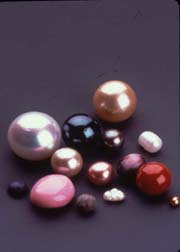
|
|
| PRECIOUS PEARLS--Lustrous colored pearls at American Museum of Natural History. | |
PEARLS—
Natural, Cultivated, & Splendidly Mounted At the American Museum of Natural History
[Closing April 14, 2002] If you've been feeling rather sad, even desperate, the past few weeks—owing to ongoing uncertainties, scares and hysteria—why not divert yourself with pearls?There are no less than 500,000 of them on view on Central Park West!
Called "The Queen of Gems," they take solo-turns or adorn other objects in Pearls, at the American Museum of Natural History. There are some 800 stunning objects in this show.
In fact, it is billed as the "most comprehensive presentation ever mounted on pearls."
It is difficult to top Diamonds as an exhibition subject. The American Museum previously had a remarkable range of diamonds to display in a similar show.
But its new show focusing on Pearls is almost as impressive. As with diamonds, however, the museum's curators have to keep its primary mission in mind.
Natural History has very little to do with Empress Josephine's diamond tiara or Marilyn Monroe's pearl necklace. Incidentally, Joe Di Maggio bought it for her in Japan.
Still, if any museum today wants to attract a large public, a little bit of glitter can hardly hurt.
Diamonds in the rough are interesting as part of nature—up to a point. They are certainly more interesting than coal, which is just another form of the carbon compound. Museum visitors long to see the diamonds transformed into jewelry and works of art.
That's also true of pearls. But the natural genesis of a pearl is visually much more interesting than the formation of diamond crystals.
The growing of cultured pearls is even more interesting—and some of the stages are shown on videotapes in the current American Museum show.
Jewelry and jeweled artworks, apparel, and objects are amply on view as well. They have been loaned from public and private collections around the world. The show will later move to the Field Museum in Chicago.
Items range from 90-million-year-old fossil pearls to Stefan Hemmerle's contemporary Spider Brooch. There are also pearl brooches made for Queen Victoria and American operetta star Lillian Russell.
You can buy some pearl jewelry in the show-shop that's less expensive than its diamonds were for the last Jewel Show.
But you might wish you'd brought along a flashlight for the actual exhibit. The light-levels are very low. Can exposure to bright light be harmful to pearls?
The installations are very tightly conformed. A lot has been ingeniously crammed into the special-exhibitions spaces. But even at the press-preview—without the customary weekday crowds—it was difficult to move through the displays.
Treasury of the World—
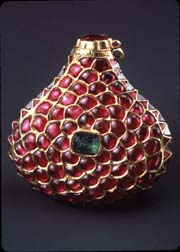
|
|
| MUGHAL RUBY-STUDDED FLASK--From India, via Kuwait, to the Met Museum. | |
Jeweled Arts of India
In the Age of the Mughals
At the Metropolitan Museum
[Closing January 13, 2002] This glittering ostentation of jewels, jewelry, and jeweled objects was on view in London in early September at the British Museum. Fortunately, the terrible events of September 11 did not delay its opening at the Met Museum.
The wonder is that such a stunning and complex exhibition could be dismantled, packed, shipped, and redeployed in the Met galleries in such a short time.
Considering New Yorkers' recent—and somewhat sudden and enforced—interest in matters Muslim, this handsomely mounted show could not come at a more opportune time. Though its donors, object-owners, planners, and curators could not have imagined such a harrowing temporal context for its exposure.
The 300 wonderful artifacts on display are on loan from the Kuwait National Museum. Its al-Sabah Collection is the world's most outstanding assemblage of Mughal jewels and similar priceless jeweled objects from the Arab Muslim World.
Kuwait, it may be remembered, is that oil-sheikdom which George Bush the Elder liberated in "Desert Storm," the Gulf War. He was Commander-in-Chief of the forces who freed Kuwait's oil-wells from the clutches of Sadam Hussein—who Bush at that time said is "worse than Adolf Hitler."
Hussein, however, is still there, still in power, still brewing chemical & biological weaponry. He may even still have some of Kuwait's Moghul jewels!
Before Desert Storm—after Kuwait had been overrun by Iraqi soldiers—Sheik al-Sabah's irreplaceable collections were plundered and taken to Baghdad by Iraqi archeologists. Then the National Museum was burned to the ground, including the wonderful 14th century Moroccan doors at its entrance.
Through the efforts of the UN, most of the collections were returned to Kuwait. Minus some carved Indian emeralds…
But, in the meantime, the Mughal Jewels are over here. One would like to say: Safe from Saddam at Last!
In view of the Taliban's fatwahs against Graven Images and ancient Buddhas—and Western European Civilization as well—the Met would do well to tighten security.
These fantastic jewels and ornaments are sumptuous almost beyond belief. But do not imagine that those Mughal Indian rulers were in the habit of breaking up the multi-jeweled setting of a saber-hilt to feed the poor.
[By the by, you can alternatively call these dynastic potentates Moghuls, from which we have derived Mogul, as in "Hollywood Motion-Picture Mogul."]
The Mughal Dynasties ruled in India, Muslims and Hindus alike, from 1526 to 1858. At which time, the British had new, improved colonial ideas for governing the Asian Sub-Continent.
One of the loveliest—but least glittering—of the precious objects in this exhibition is a cameo miniature of Shah Jahan. He was the sorrowing lover/husband of Mumtaz Mahal, for whom he built the Taj Mahal. Not all Muslim women, then or now, were/are treated like slaves or servants.
This art-loving ruler's story is a romantic tragedy, in fact. He was imprisoned to the end of his sad life by his second son, Aurengzebe. This ferocious, power-hungry prince poisoned his elder brother, the rightful heir. Then he seized power even before his father was dead.
This tale was told across Europe. In England, it was transmuted into a heroic tragedy, Aureng-Zebe, by John Dryden. Christopher Marlowe even wrote a great drama about the founder of this dynasty: Tamburlane the Great. Who was also known as Timur the Tartar.
Recall these rulers, their centuries in power, and the Riches of India at the Met. Now!
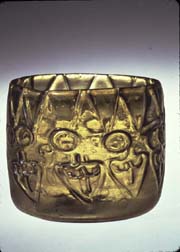
|
|
| MOLD-PATTERNED CUP--Ninth Century Arab glass fit for a Sultan. | |
Glass of the Sultans—
Rich Centuries-Old Arts
And Crafts of Islamic Glass-Blowers
[Closing January 13, 2002]
Almost a pendant to the Met's Mughal Jewels is this delicate and richly colored assemblage of Muslim blown glass. But most of these fragile and intriguing objects come more centrally from Middle Eastern cities and craftsmen, than from the Asian Sub-Continent. In the truly aptly named Dark Ages, the brilliance and craft secrets of Roman glass-makers were largely lost or forgotten. Fortunately, even before the advent of the Prophet, Arab and Persian craftsmen were experimenting and rediscovering some of the lost arts.
With the patronage of princely Muslim rulers, however, there was even more impetus to develop not only handsomely formed glass vessels but also richly decorated vases, jugs, and plates, fusing colored glasses and enamels to the surfaces.
Some of the delicately wrought and intricately decorated objects now on display were created more half a millennium ago. Although outstanding French artists in glass—Philippe-Joseph Brocard and Émil Gallé—handsomely imitated some of the finest of antique Islamic glass objects and decoration, some lost techniques seem now impossible to replicate.
The 160 objects in this exhibition have been drawn from a number of prestigious collections, including the Met's own impressive holdings. Kuwait's Sheik al-Sabah has also loaned to this show. And there's even a book about his own important and extensive Islamic glass collection: Glass from Islamic Lands [Thames & Hudson].
This is the first survey of the range of Muslim creativity in glass for over 70 years. The two concurrent Met shows may help remove some current American misconceptions about Islamic Culture and Arts, engendered by the Taliban and other extremists.
Initially on view at the Corning Museum of Glass in Upstate New York, the exhibition will travel after the Met to Athens, where it will be shown by the Benaki Museum.
Symbol & Fantasy in the Lowlands—
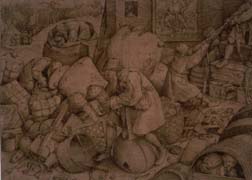
|
|
| EVERYMAN ALLEGORY--Drawing by Pieter Bruegel the Elder at Met Museum. | |
Pieter Bruegel the Elder:
Drawings & Prints On View at the Met
[Closing December 2, 2001] In a Time of Terror—when people are at very real risk in flying—Old Master Paintings do not know enough to be afraid of being crated up in Amsterdam and flown off to New York or Tokyo.
Fortunately for the Future of the Past, the curators of Old Master Collections are increasingly reluctant to loan major paintings to far distant museums. After the awful events of September 11 and its on-going aftermath, this season may see the last of the great "Blockbuster" International Loan Exhibitions.
At least the current Met Pieter Bruegel exhibition did not encourage the importation of priceless painted canvases from Amsterdam's Rijksmuseum or from Vienna's Kunsthistorisches Museum.
Not only are some of the most interesting Bruegel drawings and prints from the Met's own collections, but the papers on which they are preserved pose none of the weighty problems involved in packing, transporting, INSURING, reframing, and hanging large paintings in heavy gold frames.
If you have ever been fascinated—or even subconsciously repelled—by the often hellish, sexually surreal imagery of the paintings of Hieronymus Bosch, you will find some of them refined—if not exactly recycled—in Bruegel's own drawings.
It has been posited that Bosch was a member of a curious mystical medieval sect, in which orgiastic rites may have been a feature of worship. Whether this can be applied to Bruegel is problematic. And not at all necessary for an enjoyment of the rich detail in such moral fantasies.
For it is clear that some of the sketches—even with incorporated symbolic images which now defy translation—do in fact illustrate morals and maxims of that time. Some of them are even functional today.
Most of Bruegel's original drawings in this show were made as models for engravers who would create copper plates for a run of prints for public sale. Placing the drawings and their respective prints side-by-side provides a revelation.
Not only are they almost mirror-images of each other, but the copies are usually much less detailed, less idiosyncratic than the originals. Some fine facial lines, or a small object may be softened or omitted in the print.
And, of course, Bruegel's engravers had to incise the lettering, slogans, and mottoes in reverse, so they could be read rightly in the printed copy.
Leonardo da Vinci could write a backward hand—it was his Enigma Code—but few engravers came by such a reverse-writing talent so naturally.
Just try to write TIME IS MONEY backwards—especially in Gothic Script—and you will have some idea of the difficulties involved. Of course, you can do it with mirrors. And you can read Leonardo's notes with a mirror as well.
Also on view are some rare Bruegel sketches of landscapes made on a trip to Italy. And there are works by his contemporaries for comparison. He is clearly the best in the field.
German Gothic Romanticism—
Caspar David Friedrich:
The Met's MOONWATCHERS:
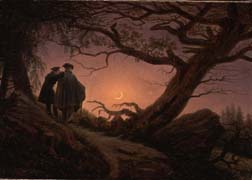
|
|
| MOONWATCHERS--Caspar David Friedrich's mysterious German Romantic vision. | |
Haunting Landscapes & Visions
[Closing November 11, 2001] Unfortunately, by the time you read this, these strangely compelling Caspar David Friedrich paintings will have left the Met's walls for their regular galleries. Dire events have prevented an earlier posting about this small-scale show.It's not so easy to see even this many/few—depending on how your look at it—Friedrich canvases in one room. Some of the most important were virtually unviewable for over 30 years, for they were in museums behind the Berlin Wall. In Berlin itself, in Weimar, Gotha, Leipzig, and Dresden.
Friedrich also had the patronage of the Imperial Russian Court, so major works were preserved in the Hermitage.
His haunting, bleak, wintry views of Germany's northern coastal areas may be an acquired taste. If you love Matisse and Renoir, Friedrich may be just too doom-laden and darkly depressive for you.
Stark landscapes, swept by winds, rains, and snow; ruined gothic churches; heavy black crosses in deserted surroundings: these are typical Friedrich images.
He often depicted solitary figures, or couples—backs to the picture-viewer—staring at a strange sunset or storm-stricken horizon. Or down the great chalk cliffs of the island of Rügen of the German North Coast.
In the Met show, framed by a malignantly black tree, the companions are looking at a cloudy, misty moon. But, in other canvases, they may be looking at—in the words of a 1930s popular song: Red Sails in the Sunset.
The late great drama/film critic of Newsweek, Jack Kroll, was an ardent admirer of Caspar David Friedrich's visions. In fact, we bonded as friends from our mutual interest in Friedrich and the novels of Edith Wharton!
Design Treasures at the Bard Center—
William Beckford—1760-1844:
An Eye for the Magnificent—
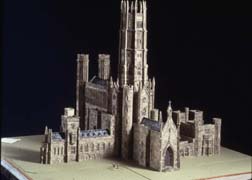
|
|
| CARDBOARD FONTHILL ABBEY--Victorian model of Wm. Beckford's Neo-Gothic mansion, shown at Bard Center. | |
Although he married and had two daughters, as a young man he was apparently totally smitten with the ephebic charms of another young gentleman of quality. This provoked a scandal from which his reputation never entirely recovered.
Indeed, although he was also infatuated with aristocratic society, noble titles, and their symbolic representations, the scandal prevented him from every being even as much as knighted. Certainly not raised to the peerage as a viscount, marquis, or earl…
Extremely wealthy, however, he was able to commission paintings, furniture, tapestries, jewels, tooled books, crystal chests, and even grandly follied homes for himself. Wherever possible, he had artists, goldsmiths, glass-makers, and engravers include one of several coats-of-arms which he claimed by distant relationship. If not by a title of his own.
One of these was the crest and shield of the Scottish Dukes of Hamilton and Brandon. Fortunately, he was able—with a handsome supplement to the holder of the title—to marry his second daughter off to the Duke of Hamilton.
His wife died early in their marriage, which left him free to bond with a male Italian collector who had tastes much like his own. And apparently a trained eye for excellence in jewels, paintings, sculpture, etc., etc.
Beckford's fortune derived from income of sugar-plantations in Jamaica. Whether he ever gave a thought to the slavery and suffering which was involved in enabling him to squander great sums on a single inlaid cabinet or an elaborate dinner-service seems most unlikely.
Although he inherited a vast and handsome neo-Palladian mansion from his father, he tore it down, wing by wing. At the same time, he was building one of the most notable follies of this era, the height of Napoleon's power in France.
The imposing palace was called Fonthill Abbey. It was dominated by an extremely slender neo-gothic tower. Which ultimately and definitively collapsed, but only after he'd already sold the structure.
By this time, he had removed to Bath, where he built another phallic monument, Beckford's Tower. It is still standing—now a landmark and tourist destination—and is sometimes called Lansdown Tower
A number of the richly ornamented objects created especially for Beckford and Fonthill—including the architect's model of the Abbey—are now on view at the Bard Graduate Center for Studies in the Decorative Arts, Design, and Culture.
The exhibition is small-scale only because the three display floors of the Bard townhouse are not very wide—though fairly deep. But the riches now being shown are worth the trip.
They did not give me a press-copy of the hefty handsome catalogue, so I cannot tell you anything about the schoolboy scandal, the Italian Companion, or the Duke of Hamilton as a son-in-law. If, indeed, any of this National Enquirer fodder has been included.
But it would make quite a movie. Especially when the great tower comes crashing down. A visual metaphor for a priapic failure, perhaps?

|
|
| ACADEMIC PIETY AT DAHESH--Paul Delaroche's deliberately dramatic Pietá. | |
Chapter & Verse at the Dahesh—
TELLING TALES II:
Religious Images
In 19th Century Academic Art
[Closing January 26, 2002]
Part I of the Dahesh Museum's exploration of religious or semi-religious themes in the Academic Art of the 19th century was both interesting and attractive. But it dealt largely with the Olympian Legends of the Gods and Goddesses of Greece and Rome. Of the great men and women of the Age of Heroes. The second—and one presumes—final installment of "Telling Tales" offers fewer visual, intellectual, and emotional rewards. Part II focuses on Academic paintings and sculptures inspired by Christian Saints, Jewish Prophets, Biblical Narratives, and—to be Holy Land-Inclusive—Muslim/Islamic Themes & Scenes
To imply that much of this admittedly finely crafted workmanship was indeed "inspired" by the lofty religious protagonists or themes in these "Tales" is quite a stretch.
It's all too clear that most of the talented artists were not exactly inspired. Nor visited by angels at midnight and struck with the pious need to depict those angels carrying Saint Catherine of Alexandria to her tomb. Sort of a Divine Berlin Airlift, only cruising over the Holy Land! This image is almost saccharine in its pious sentimentality.
Winning a medal at the Salon—or at least admiring reviews—was very important in attracting clients and patrons. Religious subjects were In.
These canny, worldly—and mainly Parisian—painters and sculptors knew very well that grandly concieved but patently pious paintings would surely sell much more rapidly—and for much more money—than visions of peasant girls milking cows in Normandy.
Unless, of course, that peasant girl was in Domremy instead. And in her garden, with St. Margaret and St. Michael up in her apple-tree, telling her to Crown the Dauphin in Rheims Cathedral. You can actually see that great canvas of St. Joan at the Met Museum.
I like it, not for its religious symbolism, but for its depiction of a simple girl of long, long ago, in a rural scene. It's much more interesting than clouds of angels bearing saints aloft… And less stressful than a melodramatic Crucifixion.
The Temptation of Saint Anthony offers a lot of scope for the imagination. Medieval artists ran rampant with fiends, demons, and monsters. Unfortunately, no such wild fantasies are on offer at the Dahesh currently.
When a lovely and voluptuous young Christian virgin in picturesque attire is struggling frantically to free herself from the rape-minded clutches of muscular and heavily mustached Muslims, the Academic artist clearly was focusing more on Sex & Violence than on the Spiritual & Cultural Clash of Two Great Religions.
So much for Piety in Painting!
At the Morgan Library:
Nothing To Declare But His Genius!
OSCAR WILDE:
A Life in Six Acts
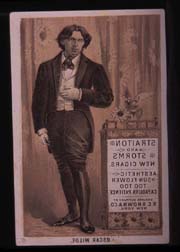
|
|
| OSCAR WILDE LECTURES--Program from "A Life in Six Acts" at the Morgan Library. | |
The cane-carrying Joyce is The Thick with the Stick. Cockles & Mussels, Alive Alive-O, Molly Malone is The Tart with the Cart.
The multi-colored marble figure of Oscar Fingal O'Flahertie Wills Wilde is reclining on a large rock in the main park. It is known as The Fag on the Crag.
As an author, Wilde is perhaps best known for such witty social comedies as The Importance of Being Earnest, An Ideal Husband, and Lady Windermere's Fan. But he also wrote—in French—the infamous Salome, which became a Richard Strauss opera.
He was also a magical spinner of tales, especially of fairy-tales for children. Which were also metaphoric messages about the mysteries of life for adults. His Happy Prince and Other Tales makes, in fact, quite a contrast to his darkly ominous and prophetic novel, The Picture of Dorian Gray.
The beautiful, privileged, carefree young Dorian, in Wilde's seductive fiction, embarks on a career of unbridled sensation and indulgence. His momentary passions and enthusiasms destroy others. But he seems unchanged over the years…
The selfishness, evil, and debauchery do not appear on his face or in his figure. Instead, they are concealed in his attic, recorded on an oil portrait which becomes increasingly horrific to behold.
The story of Wilde's own descent into disgrace and imprisonment—from which he was never able to recover, nor to find the will or the skill again to write his sparkling dramas—has echoes of Dorian Gray.
And it is a story by now almost too well known to bear repetition. But Oscar Wilde was something like Dorian, who wanted to experience all sensations, even the most dangerous.
Oscar lived an eminently Proper Victorian Family & Social Life, in a lovely home with his loving wife, Constance, and his darling children. He was lionized, admired, envied, and even parodied in Gilbert & Sullivan's comic opera,
Patience. But he was also having an affair with the petulant young Lord Alfred Douglas, who himself was something of a Dorian. Constance was home with the children and nanny, while Oscar and Lord Alfred were men about the town, seen at the Cafe Royale and other smart locales.
And Wilde was also having, as they say, "a little bit on the side." But he wasn't dallying with sluttish serving-girls. He favored postal messenger boys and other nubile lads eager to earn a few pence extra.
Now at the Morgan Library, Oscar's entire comic/tragic melodrama is unveiled in Six Acts—with many of the original documents. This fascinating survey of Wilde's dramatic rise to fame—and equally swift descent into infamy—comes to Manhattan from the British Library in London.
Play, poetry, and fiction manuscripts—with author's notations and corrections—are on view, as are important photos and letters. His only writings after his downfall but of major importance—The Ballad of Reading Gaol and De Profundis—are of course included.
The exhibition is visually and textually very wide-ranging. It offers an insight into the life and culture of Wilde's London as well.
Even Homophobes may find something of interest in this survey of a brilliant life ruined by self-indulgence and—ultimately—by arrogance. Wilde flaunted his friendship with Lord Alfred. He offended the proper and the pious with his dress, his ostentation, his mannerisms, his cutting wit, and even his success.
As he is reported to have said to an American Customs Officer: "I have nothing to declare but my genius!" That's clever, but also arrogant. As he intended it should be.
The Very Reverends Jerry Falwell and Pat Robertson might very well cite some of the materials in this exhibition as evidence of the evils of the Love That Dare Not Speak Its Name.
The Pope has said that the Church hates the Sin, but loves the Sinner. That seems very generous and loving. And Oscar would have been comforted by that thought, as he was received into the Catholic Church on his deathbed.
But what became of poor humiliated Constance and Wilde's innocent young children is seldom discussed when the brilliance of Oscar is the topic.
Fortunately, in this show all is disclosed. Wilde's children took on the family name of Holland. And Wilde's son, Vyvyan Holland, wrote a book about his experience as the Son of Oscar Willed. Very important family treasures and documents have been loanded by Wilde's only grandson, Martin Holland.
At the Met Museum:
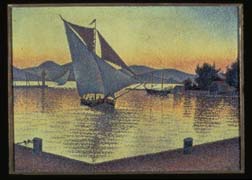
|
|
| SIGNAC AFTER SEURAT--Georges' disciple Paul paints Port at Sunset in colorful pointillisme. | |
Seurat's Surrogate—
Paul Signac: 1863-1935:
Master Neo-Impressionist
[Closing December 30, 2001]
Not even Stephen Sondheim's epigones are going to write a musical about Paul Signac. Neither his own pointillisme paintings nor his life offer the materials for a musical comedy on the model of Sunday in the Park with George.Nonetheless, Signac's artistic achievements are interesting and often charming. His development, virtually self-taught, into a disciple of Georges Seurat and his theories of color-harmony are visually and textually chronicled in the Met's new blockbuster.
Seurat and Signac weren't the only French painters to attempt depict nature and society with a series of tiny dots of color. Or, as in later Signac canvases, small mosaic-like squares of color.
Bu this form of Neo-Impressionism did not really capture the imaginations of younger artists. Or of the art-collecting public. So it has become rather a colorful footnote to the story of French painting beyond the Academic into Modernism.
But the seventy Signac oils and the many watercolors on view at the Met are often so luminous, so joyous that this is a show so beautiful you won't want to miss it.
My favorite Signac canvas—and obviously a winner with many, as it is so often reproduced and loaned for other exhibitions—is his surreal pinwheel of pointillist dots of color, MoMA's Portrait of Félix Fénéon.
The thrust of both the exhibition and the catalogue, of course, is to elevate Paul Signac, if not to the firmament, at least to the Pantheon of Modern French Artists. This may be beyond Signac's actual achievements. Only God can make a tree, as the poet Joyce Kilmer once wrote…
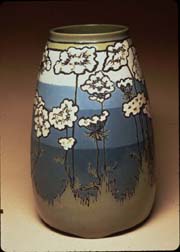
|
|
| AMERICAN ARTS & CRAFTS--Sara Galner's vase, inspired by example of Candace Wheeler, first American woman designer/decorater. | |
Women's Arts & Crafts:
Art Nouveau in the United States—
CANDACE WHEELER:
The Art & Enterprise
Of American Design 1875-1900
[Closing January 6, 2002]
You can always learn something new and astonishing in the American Wing at the Metropolitan Museum. The Henry Luce study-section, for example, is crammed with glass-cases filled floor to ceiling with American Arts & Crafts. Even if you have often admired the marvelous Versailles Panorama of John Vanderlyn, you will find something new among the hedges and trees of this massively extensive 19th century vision of the great formal gardens of Versailles.
And there are periodic special exhibitions spotlighting hitherto neglected aspects of American Art & Design. The current retrospective of the career of Candace Wheeler is just such a show.
The Met's press-release describes her modestly as "America's First Important Female Textile and Interior Designer." It also states that this is a Major Retrospective.
Frankly, I had never before heard of Candace Wheeler. Or her textiles. Was she the Martha Stewart of Victorian America?
Initially viewing some of her intricately pattern-replicating textiles, I thought at once of William Morris and the English Arts & Crafts Movement.
Certainly there are affinities in the styles and designs—even the materials and workmanship—of Morris and Wheeler. Her designs are certainly closer to Morris than they are to representative French Art Nouveau patterns of the same period.
Wheeler did function also as a precursor of Martha Stewart, through her many articles and books about design, taste, and interior decoration. Indeed, she paved the way for other arbiters of taste, including the distinguished American chronicler of New York Society, Edith Wharton. Among Wharton's earliest books was a study on decoration of houses with Ogden Codman!
But Candace Wheeler was much, much more than a taste-maker or social arbiter.
She was also an artist and a designer of considerable resource and technical skill. Her textiles were distinguished by her choices and blends of materials, including metallic threads.
Wheeler made a name for herself as a designer in a time when men dominated the field. She even had a early partnership with Louis Comfort Tiffany.
But she went on to establish her own firm, Associated Artists. And she was one of the first to encourage women to develop their own skills as designers and crafts-persons, using their designs and work in her own projects and providing an outlet through her company for women's textiles and decorative objects.
This was a godsend for talented but untrained women who had no preparation for the world of work. In the late 19th century, spinsters and women widowed or abandoned often had nowhere to turn, unless their families could support them. Wheeler not only gave them work and training, but she also encouraged them to develop creatively.
So seeing this exhibition has given me—and I'm sure, many who also will see it—a real appreciation of the life and work of Candace Wheeler. Not only what she accomplished by herself, but also what she did for American Women!
And the textiles and decorative objects on view are also worth the visit!
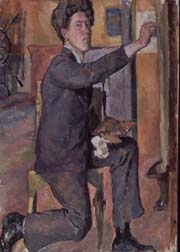
|
|
| SELF-PORTRAIT OF ALBERTO GIACOMETTI--On view at MoMA retrospective. . | |
Sculpture at MoMA:
Elegant Elongation—
ALBERTO GIACOMETTI
[Closing January 8, 2002] Opening in October, the giant Giacometti Retrospective at MoMA is a splendid birthday salute to this singular artist on his 100th Anniversary!His signature works—at least for many admirers of Modern Art—are those strangely elongated, emaciated bronzes of abstractly human figures. They are from his so-called "classic period," from World War II up to his death in 1966.
There are over a hundred artworks from this period, not all of them starving sculptures. Among these images are landscapes, still-lifes, and portraits of family and friends.
The exhibition—from the Kunsthaus in Zürich—has some 90 sculptures, 40 paintings, and 60 drawings. So the filament-thin figures, while they do dominate certain gallery areas, are not the whole show.
In effect, this exhibition shows the painter/sculptor's development from his earliest artistic inclinations. Emphasis is placed on three periods of creativity. The first is from 1929 to 1934, when he was influenced by avant-garde experiments such as Surrealism.
His Spoon Woman bronze from 1927, suggests the "primitive" influences which also intrigued Picasso and other Paris modernists. It looks like some strange African tribal totem.
But Caress (Despite Hands) , his abstractly shaped notched marble sculpture of 1932, goes beyond this primal influence toward the perfection of a Noguchi form.
In the same year, he made an amusing Constructivist piece, a kind of set-model of glass, wood, ands string, titled The Palace at 4 A. M. In the MoMA show is also a fairly conventional 1932 sketch he made of My Studio.
So Giacometti was still experimenting, not committed to a subject-matter, nor settled in a distinctive style. From the evidence of this retrospective, however, he was always open to experiment.
The period 1947 to 1951 was the watershed of the elongated abstracted people. As well as of elongated body-parts: The Nose—in its own box-frame. And an Arm, suspended like the nose, from an overhead bar on the box.
While some have suggested that the horrors of the Holocaust and the hunger which stalked Europe during World War II may partly have inspired his super-starved figures, there are no evidences of agony in such figures as Walking Man.
If anything, they are sedate, self-assured. Some, in their super-attenuation, looking down their long, long legs from seemingly great heights, are almost Hieratic: Cult Objects of Worship.
But the Nose and the Arm certainly show he had a sense of fun with such forms.
The geometrics of these swinging, hanging sculptures' framing-boxes is also apparent in powerful sketches he made in the 1950s of Diego Rivera, Jean Genet, and himself.
This is a richly varied show, with much to savor visually and emotionally and to think about, as well. Do those long bronzes have something to say to us, beyond what may have been in Giacometti's mind when he made them?
Popular Culture, Landmarks,
Celebrities, Broadway Theatre—and More!
HIRSCHFELD'S NEW YORK—
AT MUSEUM OF CITY OF NEW YORK
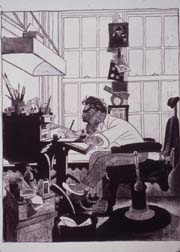
|
|
| SAL HIRSCHFELD IN HIS BARBER-CHAIR--Self-portrait caricature in show at Museum of City of New York . | |
Over the years, drawing cartoons related to new Broadway and Off-Broadway Shows, the inimitable caricaturist Al Hirschfeld began to work his daughter Nina's name into the hair, features, and clothing of stage-celebrities. As well as into the furniture, decor, or wallpaper.
Integral with his signature would be a numeral: 3, 5, or 8. Nina-hunters knew they were looking for three or five or eight hidden uses of her name.
The lively new show at the Museum of the City of New York certainly has some of those Hallmark Hirschfeld's on display. But, as this is a show about Hirschfeld's view of New York, it is much more wide-ranging.
It begins almost at Hirschfeld's beginnings as an artist. He sold his drawings to a variety of New York publications to get himself established. When he found a congenial editor, he could also market sketches he'd made of Manhattan scenes and fashions.
In fact, much of the early material in this exhibition is less about Celebrity than it is about City. It's even a kind of Time Capsule of 20th Century Manhattan.
Older viewers of the show—which is largely in black & white, for obvious reasons—will find themselves strolling down an especially stylized and satiric Memory Lane.
For younger visitors—especially the school-classes which are a welcome constant at the museum—Hirschfeld offers a pictorial introduction to chapters in the city's social and cultural life which are past. But not yet quite frozen into History.
But it's not all about New York, celebrities, or Show Biz. Hirschfeld was a great pal of the New Yorker's resident satirist, S. J. Perelman. When Perelman was commissioned to write some travel commentaries, Hirschfeld went along to illustrate their adventures. One jaunt was serialized and published as a book as well: Around the World in Eighty Clichés.
At the Brooklyn Museum:

|
|
| MODERN IN ANY AGE--1946 Spacelander bike in "Vital Forms," at Brooklyn Museum. | |
VITAL FORMS:
American Art & Design
In the Atomic Age, 1940-1960
[Closing January 6, 2002]
I have no idea how old or young Brooke Kamin Rapaport or Kevin L. Stayton may be. I should have asked them when the press was being shown through this Thrift Shop of a show which they have just curated for the Brooklyn Museum of Art. Considering what they chose to represent Art & Design in America—from World War II to 1960—they surely could not have lived through this period of ghastly bargain-basement Modernism.
When dreadful, tacky 1950s objects first began appearing in smart shops—which had previously specialized in American Art Deco—I realized I was Over the Hill. And that the generally appalling taste of the Post War Period—which owed a lot to the Bauhaus and the International Style, without very much style—had now been given the Modern Arts Seal of Approval, if not actually Canonized.
Yes, the curators have presented a cross-section of Popular Taste, but being spread out over two decades, it all melts together as in the Atomic Blast featured in the show.
We do get a World War II ration-book, true. I still have mine, in fact.
But the design and art of the Four War Years was something special, not least because "Lucky Strike Green Has Gone To War." Real and government-engineered shortages—"Don't You Know There's a War On?"—created all sorts of privations and survival-strategies. Painting on simulated silk-stockings was the least of it…
Yes, Uncle Sam did Want You. But there were many other interesting posters and arts-projects which were distinctive of that time. And which are not to be seen today.
There was, for instance, a US Army series of paintings—reproduced for Company Day-Rooms—of Americans In Combat in all our Heroic Wars. I must still have some of those tucked away someplace…
But how could the Brooklyn Museum have known, when this show was being planned, that an Art & Design—and possibly also Propaganda—Show of America At War would strike exactly the right chord at this time?
This is surely a topic, or theme, which ought to be immediately explored. And put on display! Americans At War: I, II, & III. If, indeed, we are sliding into World War III…
Meanwhile, back on Eastern Avenue, it's still 1943, or 1947. Or 1952, or 1956. Lordy! Did we really think those awful fashions and objects were attractive? Snoods and Wedgies?
OK, Sandy Calder is special. Isamu Noguchi has style to spare. In fact, it's very spare indeed. Ray and Charles Eames designed some great chairs and other furniture. But America cannot take credit for the late-50s craze of Danish Teak.
Until recently, I still had my quick-wash yellow canvas seat and my Butterfly-chair geometric frame. It cost me $5 on Telegraph Avenue in Berkeley when I got out of the US Army in 1955. It was cheap because it was Made in Japan…
Those of us who soldiered on through World War II, Harry Truman, Dwight D. Eisenhower, the Marshall Plan, and cheap, ugly American design have a hard time seeing anything of beauty in the artifacts of that time.
But the objects on display at the Brooklyn Museum do, it is true, offer a kind of survey of the generally Bad Taste of that era. Perhaps they'd look better if they weren't set off against walls painted the intensely saturated and truly icky greens, browns, and oranges of that odd time of transition.
Yes, Russel Wright did use such colors for his dishes. And I still have a set of plastic Mel-Mac dinner-ware in exactly the shades of brown and orange that depressed me so tremendously at the Brooklyn Museum.
I think I hate them, but never used, they are almost like new. So I haven't the heart to throw them out. Maybe a trip to the Thrift Shop?
But I won't give up my rainbow-colored Slinky. It sits on my dining-room table because I like its form and color. I don't make it perform. But the new Brooklyn Museum show also has a Slinky, so maybe there were some items of Good Design in the 1950s?
They also have Hula-Hoops on display. You can even buy them in the show's Gift Shop! This was a dumb idea at the fad's height. But it made a lot of chiropractors rich while it lasted…
A Golden Baroque Altar
Reaching Up Toward Heaven—
Or At Least the Guggenheim's Rotunda!
BRAZIL: BODY AND SOUL—
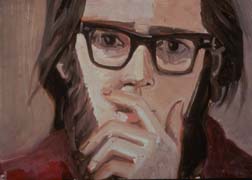
|
|
| TED BERRIGAN--One of Alex Katz's Small Paintings at the Whitney. | |
Portuguese-speaking cinema is almost the least of the visual astonishments in store for those who go up Fifth Avenue to the Landmark Guggenheim.
Even if you are not remotely interested in Amazonian Indian feather-decorated ritual objects, or in the most modern of Brazilian Modern Art, you should at least make a pilgrimage to the Frank Lloyd Wright Rotunda.
There, an immense golden baroque/rococo altar has been assembled in recent weeks. It rises up almost to the circular glass skylight. It has been fascinating to watch it being put together—as the World Trade Center disaster delayed its arrival for the opening of the Guggenheim blockbuster: Brazil: Body and Soul.
Unlike almost all the other countries in South and Central America, Brazil is not Spanish-speaking. [When Belize was British Honduras, both English & Spanish were spoken, it's true.]
This vast and rich land was colonized by Portuguese. Their adventurous navigators and explorers—in strongly-rigged ships—sailed round the world, planting colonies in Indian Goa, in Chinese Macao.
When Portugal's Prince Henry the Navigator first gave his people the passion to push out beyond their rivers and harbors onto uncharted seas, he unleashed a tide of European colonization of other continents. This certainly brought riches to Portugal.
But it also brought European culture and religion to indigenous peoples who already had their own languages, beliefs, rituals, customs, and arts & crafts.
Among the treasures on display at the Guggenheim are colorful Catholic religious images which profit from the mingling of European styles and visions with native forms and materials. Portuguese Baroque underwent a sea-change in Brazil.
A collection of great wooden ships' figureheads also shares in this wedding of two worlds in wood-carving.
Some of Brazil's modern artists are well known on the international scene and are well represented in the current show. From the 1920s and 30s, there are works by Victor Brecheret, Emiliano Di Calvacanti, Lasar Segall, and Candido Portinari.
Concrete and Neo-Concrete artworks of the Post War decades have been selected from the works of Lygia Clark, Lygia Pape, Sérgio Camargo, and Luís Sacilotto, among others.
There are two installation-rooms which are quite striking. The first chamber is dead white. It is hung with hunks of black carbon, suspended at various levels. You need to bob and duck to make your way through this aerial maze of floating coal. But the room's creator, Antonio Manuel, has scored a hit with this vision.
Around the corner is a long high white gallery. On a slim pedestal near the entrance is a small roughly carved and colored figure of a man on horseback—almost a toy, but certainly a naive object.
Behind it, on the two walls facing the entrance, is an elongated, distorted, imaginary blue shadow of a Man on Horseback. But it's not the wooden figure at all. Instead it is a major bronze military monument in Rio. Striking and also amusing…
By the way, that immense golden altar was not created for this show. Nor was it plundered from some great metropolitan cathedral.
Woodworms work their way through the thickest of hardwoods. And the most glittering of gold-leafing gets dusty with the passage of years, decades, centuries. So the altar was taken to pieces and carefully conserved and restored.
After its stunning showing at the Guggenheim, it will be dismantled and re-assembled back where it came from: São Bento de Olinda. Seeing such wonders, one realizes that European Baroque has been improved upon in the New World.
With the Guggenheim's director, Thomas Krens, establishing branch Guggenheims in Berlin, Bilbao, and even in Las Vegas—with St. Petersburg's Hermitage Museum, this special tribute to the Arts & Crafts of Brazil looks suspiciously like an exploratory feeler for a new Guggenheim branch in Brazilia, if not in Rio.
Even BK—or Before Krens—there was already a [Peggy] Guggenheim Museum in Venice. And there's still the possibility of a Guggenheim in Salzburg, although locals are determined to create their own Museum of Modern Art where the old Cafe Winkler stands.
Nonetheless, the Brazilian government has itself become more alert, even aggressive, in promoting the land, its peoples, its history, its culture. Recently, Brazil published a wonderful book in English about itself, primarily for distribution to public libraries and schools.
I was given a review-copy, which was nice. I'd have liked a press-junket to Brazil as well. I still would, as I have never seen this impressive country.
But the least I can do, under the circumstances, is share my report on the book, which was already on this website some months ago. At that time the stocks of the volume were growing low, so the cultural functionary to whom I talked feared there might not be enough copies for all the schools and libraries who wanted the book.
If Brazil can afford to bring that immense altar to New York, as well as to mount such a colorful, vibrant show, it can certainly afford a second press-run of its handsome and very informative book:

|
|
| ANDY WARHOL MAKES A FILM--Lupe, one of the "Projected Images" in new Whitney show. . | |
All About BRAZIL!
Impressive & Colorful New Book
Could Be Added To Your Library
Did you know that Brazil was once an Empire?
And that its nominal ruler, Emperor Dom Pedro II, was an honored guest in Philadelphia at the inauguration of America's Great Centennial Exhibition in 1876! I found that out when I was looking at old prints of the American 19th Century. There was the Emperor himself, with his entourage, before the immense Corliss Steam-Engine.
I already knew what had happened to Emperor Maximilian of Mexico. He was brutally slaughtered by a Revolutionary firing-squad. That drove his unfortunate widow, Empress Carlotta, mad.
What eventually became of Emperor Dom Pedro, to this day I do not know. I should have looked that up. I do know he wasn't an Absolute Monarch, but served instead a nation with an elected legislature.
My neglect may be some indication of a typically American disregard for the histories of other nations in the so-called New World—who also have very much the right to call themselves American as well.
But, if you are able to study the wonderful new book, Brazil: Territory, Land, Work, Culture, you won't get a traditional History Lesson either.
Or you may get it incidentally, as the text and the striking color photos explore the four aspects of Brazilian Life listed in the title. In the opening Setting—or historical-geographical-ethnographical background—you can discover important facts about Brazil's Past.
But this volume is intellectually really more about Brazil's Future. It is very clear—from the organization and effective prose—that the Past and Present are inspirationally understood in Brazil as Prologue.
A Prologue which requires much greater interest and understanding from Brazil's neighbors to the North. And in the European Community as well!
Brazil's Future—for an extremely diverse ethnic population, which continues to grow—is intimately linked to economic, political, social, and cultural developments abroad.
So it is of paramount importance that people of influence and aspiration elsewhere know more about this great nation which can also be a Great Partner in many undertakings.
Not to overlook the real need for accurate information for the general public in the United States and Canada. Are they getting the truth about Brazil? About its Peoples? Its Raw Materials? Its Industries? Its Economic Problems? Its Rainforests? Its Cultural Life?
When Portuguese Explorers discovered this great Wilderness, they—like Columbus—thought they had possibly found the Biblical Eden. The Noble Savage in all his Unspoiled Innocence.
But as soon as some Portuguese found themselves on Native dinner-menus, the "noble" epithet was dropped. And the emphasis rested upon "Savage."
Portuguese language and government was imposed. And the Roman Catholic religion was widely propagated. So an overlay of European Traditions partially transformed those areas which became important port-cities and agricultural centers.
But countless shiploads of African Slaves also began to transform aspects of the new nation's life.
For some naive Americans—who have been to Brazil—this historic mixture of peoples, cultures, aspirations, and energies may be best summed up in the color and excitement of Carnival in Rio.
This exciting new book has only a few photos of Carnival. The text in fact makes a point about the many misunderstandings of Brazil's culture which have arisen from a brief visit during Carnival.
The Carnival Spirit is much more complex than outsiders can comprehend. Just as the vastness and complexity of this amazing, challenging, and very diverse land seem more than even Brazilians can themselves comprehend.
Some of the powerful photos of Nature in this book make Brazil seem still a Romantic Wilderness. They make it appear a very Paradise, an Eden worthy of the dreams of Portugal's farsighted Prince Henry the Navigator.
But there are also extremely evocative images of simple faith—women and men of various backgrounds united in prayer and celebration. There are interesting shots of skilled craftsmen and women, plying ancient trades.
And there are photos of traditional farming and of the most modern mechanized agriculture. Not to overlook strong compositions of cogwheels & cranes, of Heavy Industry and Postmodernist Construction.
In some parts of Brazil, there may be only rude huts or shacks. In others, there are amazingly preserved monuments of Baroque Architecture.
But in the cities, there are great new buildings which rival some of Manhattan's finest. The book also illustrates old and new Temples of Culture—and some of the notable arts manifestations which occur there.
Bidu Sayao is not the only great performing-artist Brazil has given the world.
And what Brazil has done for the World of Soccer needs no further emphasis. Soccer, as this book notes, began as an amateur sport for the Elite Families—for those with a Portuguese heritage and/or wealth & land.
Initially, no Black or mixed-race people could play. Or even watch. Over time—as the way Soccer is played could not be kept a State Secret—it became apparent that the very best players traced their ancestry, not to Estoril, but to Senegal.
It could be said that both Soccer and Carnival—each in its own way—have been democratizing influences for Brazil's diverse populations. Both pictures and text in this book suggest that democracy is still a Work in Progress.
Even if Brazil: Territory, Land, Work, Culture had no text at all, only its breathtaking photos, it would be well worth owning.
If you are a Teacher, a School or College Administrator, or a Librarian—or even a friend of any or all of these—and you would like to make this valuable and most informative book on Brazil widely available in your reading-community, please contact the Brazilian Consulate-General in New York City.
There are only limited stocks remaining of this book, so requests should be made on official letterhead, with a statement regarding the potential readership: Students, Teachers, Seminars, Researchers, Editors, Opinion-Makers, Travel Writers, Discussion Groups, and/or the General Public.
Please address requests to one of the three options listed below:
Consulate-General of Brazil in New York Cultural Department/Attn: Mr. Marcelo Salum 551 Fifth Avenue/S-210, New York, NY 10176
· FAX: 212-370-3925
· Email: book@consuladobrasilny.org
This excellent introduction to the World that is Brazil—and of Brazil to the World—was originally published solely for distribution through Brazilian Embassies and Consulates. Its purpose was—and is—to reach as wide as possible an audience of people interested in learning more about Brazil. Especially teachers and "opinion-makers."
But this would also be a most helpful book for those who like to travel and who want to know more about our Great Big Neighbor in the Southern Hemisphere!
Travel-agents should also find it full of suggestions for their clients. Especially those adventurers who are always looking for new sights and scenes, new mountains to climb, new worlds to conquer—at least visually.
Although I've been invited by various Latin American cultural-agencies to festivals and arts-events in Venezuela, Colombia, Mexico, Guatemala, and Panama, I've never had the good fortune to visit Brazil.
This marvelous book makes me want to pack my Mac Powerbook laptop, Sony tape-recorder, and Nikon cameras for a cultural exploration of Brazil. One glance at the photos in the book, however, make it clear that it would take many Brazilian Journeys to survey this vast land and its many sub-cultures.
From the book, the immense land-mass that is Brazil seems a World in Itself—a Continent within a Continent!
Even those who are confirmed stay-at-homes could have a wonderful trip to Brazil just from looking at the magnificent photos in this book. You could sail along the Amazon and Negro Rivers without leaving your armchair!
Unfortunately, Brazil: Territory, Land, Work, Culture was not published for public sale. Even if you find a copy at your University, School, or Public Library, you cannot digest this wealth of information and pictorial splendor in one sitting.
But, if this report suggests it's a book you would like to have for your own home-library, or for sharing with friends—who may purposely forget to return it—please let Mr. Marcelo Salum, of the Consulate's Cultural Department, know of your interest.
His Excellency Flávio Miragaia Perri, Ambassador & Consul-General of Brazil in New York, has notified me that "a reasonable demand would trigger a new printing."
Not only will this book be a valued addition to your own library—or coffee-table—but it will make a great gift for those friends who seem to "have everything." They surely don't yet "have" Brazil in the way this pictorial & textual report will make possible!
A wide exposure of this volume should also rapidly increase the numbers of North Americans who will book flights to Rio, outings to Brazilia, and boat-trips up the Amazon.
Not to overlook that fantastic Neo-Baroque Opera-House featured in Werner Herzog's film of Brazil in an earlier time. The one in which they dragged that Steamboat overland.
Or you could see what's happening to the Tropical Rainforest first-hand, if you are a Preservationist. Perhaps reports you've read don't tell the entire story?
Two New/Old Shows at the Whitney—
Alex Katz: Small Paintings
[Closing December 2, 2001] If you are a smoker, you may want to visit the Philip Morris Whitney—across from Grand Central Station. There, a selection of Alex Katz's very small canvases—as contrasted to his better-known and rather large ones—is on view. They are representative of his small oil studies from 1950 to 1980.There's no smoking at the actual Whitney Museum on Madison Avenue. But more of Katz's works, created from 1980 to the present, are on display. They are simply presented in the intimate—read: small—Ehrenkranz Lobby Gallery.
Although Katz paints small oils for his own pleasure and fulfillment, many have been initial studies for much larger paintings. In fact, he now uses such sketches for enlargement into "cartoons" for the large-scale flattened-out portraits that are his trademark.
In addition to the contrast in size, from small to large, there's a real spontaneity and immediacy in most of the sketches which is leached out in transfer to larger surfaces. Even some landscape fragments are refreshing in these miniaturized formats.
A young mother—pushing and pulling two little girls through the show—halted in front of an especially moody, sketchy male face. "Kids! Isn't that guy handsome?"
They stared at the sketch and agreed with her. I took a closer look as well. She was right!
The Projected Image
In American Art: 1964-1977
[Closing January 6, 2002]
Did you know—or even at that time realize—that the period 1964-1977 was a "golden age" of moving-image installations? If you did not, please do not apologize or shuffle your feet in embarrassment. Most people do not know when they are actually in a Golden Age. The initial years of black & white television—with shadows of the overhead mikes seen on camera—are now regarded by connoisseurs as TV's Golden Years.
They may be right, although it hasn't all been downhill since the Army-McCarthy Hearings in 1954.
As for the loopy film-loops, minimalist slide-shows, and grainy videos now on display at the Whitney, some of them are so pretentious, perverse, or elementally Minimal that only a Curator could love them.
But do not, on viewing some of these "classics," say, or even think: "I could have done that."
No. You could nothave done it. If so, you would have done so long ago, yes? Where were you when Andy and the gang were making movies like Sleep down at the Factory?
And, even if you had had Warhol's vision and chutzpah, what good would it have done you? If no curator or art-critic was able to see it and collapse in ecstasies of admiration for your transformation of the banal into images of even more banal obtuseness?
Still, how can you argue with the fame—certainly more than fifteen-minutes worth of it at last count—of Dennis Oppenheim, Bruce Nauman, Michael Snow, and Yoko Ono?
I make a distinct exception for the work of Mary Lucier—playing favorites, perhaps? But her multi-monitor-TV installation quite some time ago at the Whitney—relating Monet's Gardens at Giverny with her own American roots—was stunning. I thought then—and still do—that it should have a permanent place in a major gallery.
MoMA MOVES TO QUEENS!
Old Swingline Staple Factory
Undergoes Post-Modernist Transformation

|
|
| VIEW FROM THE ELEVATED--MoMA's new Queens affiliate museum, P.S. 1, seen from IRT #7. | |
The current Alberto Giacometti exhibition will continue until that time. It will soon be joined by a retrospective of the German artist, Gerhard Richter. These will be the last major shows in this historic Bauhaus-inspired venue.
The streetline façade—including the Philip Johnson and Edward Durrell Stone sections—will look largely unchanged when MoMA re-opens on this site in 2005.
The essentially new museum-complex has been designed by Japan's Yoshio Taniguchi. An impressive model of the project and supporting graphics are currently on view at MoMA.
But this doesn't mean that you will not be able to see the Picassos & Matisses for almost three years. Highlights of the Permanent Collection and new exhibitions will be shown in MoMA's handsome new venue, MoMA QNS!
Don't try to scrunch out that last bit as qwnz or quince or knz. A Press Advisory notes that the correct pronunciation will be Mo-Ma Q-N-S.
QUEENS? They've got to be joking, right? That's where all those cemeteries are—on the way to the airports?
No, this is no joke. And MoMA QNS won't become a cemetery for Modern Art either.
MoMA director Glen D. Lowry and MoMA's board—led by benefactress Agnes Gund—had long realized that the current exhibition, office, and storage areas had to be replaced with larger, more efficient spaces. In fact, Lowry told the press—on a junket to the new Queens venue—that MoMA's vast collections are now scattered about the city in no less than 18 storage locations.
Initially, MoMA was attracted to the Borough of Queens in search of an existing building large enough and structurally sound enough to house and protect its tremendous and—in some cases—priceless holdings.
They found the old Swingline Stapler Factory—with floors-through featuring 20-foot-high ceilings. This recommended itself not only a potential state-of-the-art storage, conservation, research, and teaching center.
But it was immediately apparent that its grand ground-floor could make a spacious venue for ongoing exhibitions while MoMA was in exile from West 53rd.
Los Angeles architect Michael Maltzan—working with MoMA's New York architectural advisors on the building-conversion, Cooper, Robertson—has devised an ingenious series of Post-Modernist ramps to attract art-lovers into the new galleries, library, cafe, and shop.
Close by is The Factory, which will provide additional office-space for MoMA's many activities.
The MoMA website will keep old friends and new posted on projects and progress both in Queens and Manhattan. Search For: www.moma.org/momaqns & www.moma.org/momabuilds
Another MoMA website innovation is special online exhibitions. Drawing on its superlative collections of 20th century German Art, it has launched Artists of Brücke: Themes in German Expressionist Prints.
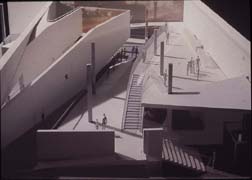
|
|
| Projected Images" in new Whitney show. 20] VIEW FROM THE ELEVATED--MoMA's new Queens affiliate museum, P.S. 1, seen from IRT #7. 21] POST-MODERNIST RAMP-AGE--Lobby entrance ramps for MoMA's new home in Queens. . | |
The move to Queens—and the need for an additional exhibition-presence—has also led to a new, productive co-operation with P.S. 1 Contemporary Art Center. It boasts the largest collection of contemporary art in the United States. But then there's a superfluity of Cont-Art out there, so it's not hard to build up a huge collection. If you have cash and storage-space…
MoMA is of course concerned that its regulars will be able to find their way out to Queens with a minimum of difficulty.
Glenn Lowry told the press that foreign visitors seem to have no difficulty in finding P.S. 1. It's only Native New Yorkers—read Manhattanites—who act as though they needed visas to get to BAM, Staten Island, the Bronx, and Queens.
To make the trip especially easy, MoMA every weekend is running regular shuttle-buses from West 53rd to a new Arts-Circuit in Queens. This includes P.S. 1, the Isamu Noguchi Garden Museum, the Socrates Sculpture Park, and the American Museum of the Moving Image.
As soon as the new MoMA QNS opens, it will be included. But you can also reach the site right now—if you want to check out the transformation from the outside—by taking the IRT No. 7 line.
You can most easily board at Times Square or Grand Central Station. As soon as the train emerges from the bowels of the East River, it becomes elevated. This offers a spectacular view of Manhattan and of post-industrial Queens. Architectural gems in Long Island City also dot the skyline.
To reach the new site, get off at the 33rd Street Station. This has been handsomely enhanced by stained-glass windows—in chunky, richly colored glass—featuring local symbols and historical references.
The neighborhoods surrounding each of the arts-complexes are rich with ethnic restaurants representing cuisines of the world. Queens is in effect a Little United Nations now. It was initially developed as a refuge for immigrants crammed into Manhattan's Lower East Side and Hell's Kitchen.
When MoMA QNS is ready, in late June 2002, it will welcome visitors Thursdays through Mondays, from 10 am to 5:30 pm. Unlike the West 53rd Street Wednesday closures, it will be closed on Mondays and Tuesdays.
General Admission will be $10. Of course this does not begin to cover the immense costs of maintaining and servicing the vast collections, mounting blockbuster exhibitions, conducting research, providing archival & library study services, etc., etc.
The generosity of corporate sponsors, arts agencies, and private patrons such as Agnes Gund, Ronald Lauder—and others whose names are often in the cultural news—do much to make this possible.
But the current Queens and Manhattan projects are costing immense sums of money. And, as Glenn Lowry told the media, attendance in the wake of the September 11 disaster had fallen off by 40 percent!
Foreign tourists—who always made a bee-line for MoMA—have been temporarily "scared off" from Manhattan. Lowry is encouraged by the increasing numbers of New Yorkers who are now coming back. Or discovering MoMA for the first time!
What is especially encouraging is that MoMA's board has been able to raise some $507 million for the new projects.
This total was reached after the World Trade Center bombings. That is remarkable, for many agencies, corporations, and wealthy citizens have had to retrench drastically in our wounded, worsening economy.
[Loney]
Copyright © Glenn Loney 2000. No re-publication or broadcast use without proper credit of authorship. Suggested credit line: "Glenn Loney, Curator's Choice." Reproduction rights please contact: jslaff@nymuseums.com.